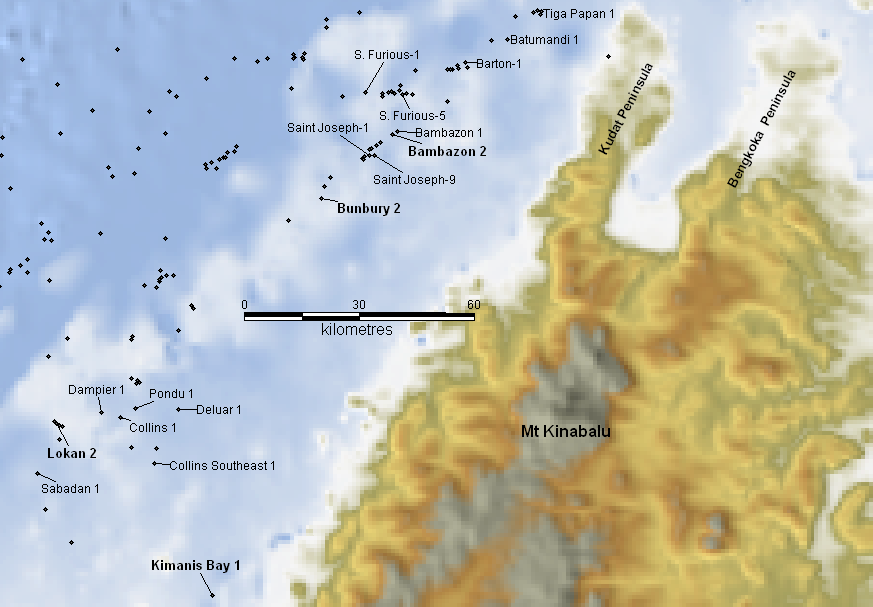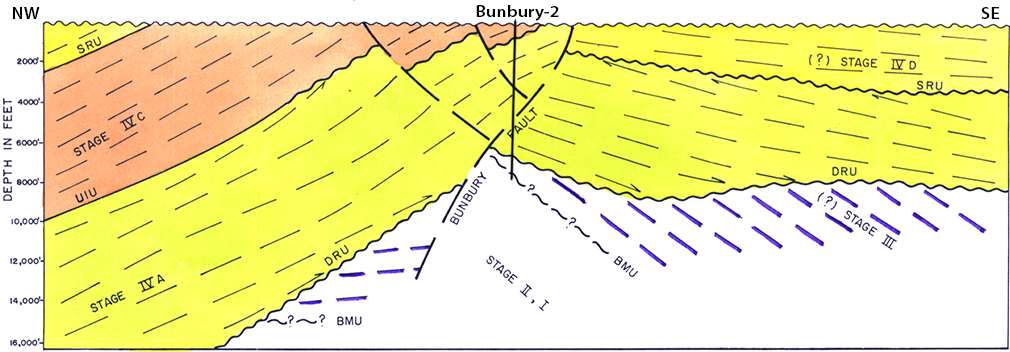This post links to three related entries questioning established models for the Proto-South China Sea slab pull tectonic model (Post 1, Post 2, Post 3)
Two recent papers (Lunt and Madon, 2017; Lunt, 2021) cited short observations of several wells off NW Sabah that, combined, have major implications for regional geology. This data greatly influences the stratigraphic reconstructions of the Stage II?, Stage III (older Cenozoic to mid Middle Miocene) and the Sabah Orogeny (latest Early Miocene to Pliocene).

The wells in question were all drilled in the late 1970’s or early 1980’s and reached Stage III sediments, in the case of two (Kimanis Bay-1, Bunbury-2) there were penetrations of pre Stage III sediments.
Kimanis Bay-1 (1981) was drilled to test a stratigraphic trap in lower coastal plain Stage IV-A beds and it drilled below possibly a compound unconformity into sediments older than Stage III, based on high vitrinite reflectance (>1.2 Ro equivalent). Seismic across the well shows the pre unconformity beds with little reflectivity but some low angle surfaces dipping towards the SE (Levell, 1987, Figure 7). These correlate to outcrops onshore, of Eocene or Early Oligocene Crocker Formation that was deformed in latest Oligocene times (see map in Lunt, 2021). Therefore the unconformity drilled by the well is a compound Base Miocene Unconformity (BMU) and Deep Regional Unconformity (DRU). The few SE dipping reflective surfaces in the seismic below the DRU in Kimanis Bay-1 might therefore be fault planes.
In Bunbury-2 (1979), Stage IV-A is lower coastal plain with sandstones to 100′ thick, claystones are locally lignitic, but there are no coal beds. At 6680′ the DRU was penetrated which separates the Stage IV-A sequence from the underlying, much older Stage III sequence of predominantly hard sandstones. Within the sandy Stage III no foraminifera were recovered (preventing an environmental assignment) but some palynomorphs were found with a slightly higher thermal maturity than the overlying Stage IV-A (roughly 0.59% compared to 0.55% Ro). The palynofloras were rich in the cool montane flora that characterises the basal Miocene and Oligocene of the region (along with the similar age restricted mangrove taxon Florschuetzia trilotata). In such poor, sandy samples and over a short section (170’) the step-like (up-hole) reduction in cool montane flora that denotes the top of Pcs 145 / base of Phc 88 pollen zones was not observed. The unit was assigned to Pcs 145, but it is quite possibly in lower Phc 88, as montane flora diminished after the change from seasonal to ever-wet on the Oligo-Miocene boundary and only reduced to trace proportions within later Early Miocene times (Morley 2000).
Seismic around Bunbury-2 and to the east is shown in Levell (1987, Figures 6 and 14). These show the Stage III beds below the DRU dipping at low to moderate angles to the SE. In some areas there are reverse faults imbricating this, but these were often formed by younger (Late Miocene) movements. The total thickness of Stage III is at least 2.5 km. The thermal maturity of the Stage III palynomorphs would, assuming a typical geothermal gradient, suggests about 2.5 to 3 km burial prior to uplift and erosion.

Below Stage III in Bunbury-2 is a section with much higher thermal maturity (c 1.4% Ro equiv.). It is significant that west of this there is no seismic reflectivity in the pre-DRU section. This 140’ of bottom hole section was composed of hard, green to red brown “shales” with thin interbeds of hard, fine grained sandstone. The benthic foraminiferal assemblages recovered from these sediments all indicate holomarine outer neritic to bathyal environments of deposition. The shales do not contain recognisable sporomorphs due to intense carbonisation. The operator (Shell) suggested “lithology and benthonic [sic] foraminiferal assemblages of these sediments are similar, to the Paleocene-Oligocene West Crocker Formation of onshore Sabah (Stage II).” and of course Kimanis Bay-1 (107 km SSW) that would be drilled a few years later. However wells to the north such as Likas-1 (150 km NNE) and Secam-1 (195 km NNE) have well-dated, fossiliferous Eocene siliciclastics with much lower vitrinite reflectance values, contrasting with the Penascosa-1 (440 km NNE) that reached Mesozoic section with Vr values of about 1% Ro.
As noted by Lunt and Madon (2017) the offshore Stage III contains 2 to 3 km of deep marine claystones ranging in age from basal Miocene (tentatively in Bunbury-2, but positively in the 1984 Bambazon-2, which drilled a short Stage III section at TD (below a fault contact) with Paragloborotalia kugleri Zone (N4 or M1 in modern schemes), deposited in a bathyal setting. To the SW Lokan-2 drilled deep marine Stage III claystones containing older Early Miocene markers Globigerina binaiensis and P. kugleri, and to the NE the Tiga Papan-1 also reached the extinction datum of G. binaiensis (19.4 Ma). The younger part of Stage III was drilled in St Joseph 9 (1987) where Zone NN5 / N9 (base Middle Miocene) was present at top of Stage III. The bathyal Stage III clays contrasting with the lower coastal plain and sandy Stage IV-A above the DRU. Bambazon-1 (1977) drilled into the Stage III with latest Early Miocene or possibly basal Middle Miocene Globorotalia peripheroronda Zone. Other wells such as South Furious-5 with a thick (c. 740 m) Stage III confirmed the later part of the Early Miocene
Synthesis
This data tells us three things:
1. Highly deformed and seismically hardly reflective Stage II (later Eocene to end Oligocene) or Stage I (pre late Eocene) beds were overlain by much less thermally altered Stage III beds. This large contrast in burial maturity is the BMU event. In the Bunbury – Bambazon – S Furious area the data indicates one of two scenarios. (A) Stage II/I beds were uplifted and eroded by several kilometres in latest Oligocene times, prior to very rapid subsidence so that bathyal N4/M1 clays could be directly overlain above this unconformity. (B) Stage I beds had already been eroded by an unconformity near the Mesozoic-Cenozoic boundary (as at Penascosa-1 and other Palawan locations) exposing high thermal maturities. An unknown degree of uplift in the latest Oligocene (as onshore Kudat, 40 km to the east) was therefore less important, but there was still a very rapid basal Miocene subsidence to bathyal conditions, so deep marine Stage III could have been deposited directly over a compound unconformity. This rapid subsidence correlates to other regional subsidences on the Oligo-Miocene boundary, and the South Banggi and Gomantong reefal limestones deposited above the Te4-Te5 boundary in north Borneo. I stress this subsidence because regionally the Oligo-Miocene boundary has been cited as a change from “rift to sag” tectonic conditions, but in many places, such as the South China Sea and north Borneo, it marked a rapid acceleration, not deceleration, in subsidence.
2. Two to three kilometers of Stage III sediments were deposited over a wide area of inboard Sabah from basal Miocene to early Middle Miocene times. Within early to mid Middle Miocene times (a short period of time) the onset of the Sabah Orogeny uplifted these beds, tilted them down to the SE and eroded the outer NW margin, almost down to the underlying Stage II/I section.
3. During the entire Early Miocene, while there was sea-floor spreading orthogonal to Sabah, there was no deformation of these Stage III sediments. Lunt and Madon (2017) and Lunt (2021) stressed this point as a contrast to the widespread deformation across northern Borneo in latest Oligocene times (latest Stage II). There can have been no Early Miocene accretionary wedge or a subduction zone anywhere close to inboard Sabah. There was no indication of compression and uplift until the younger Sabah Orogeny (after sea floor drift in the SCS had finished). Outcrops onshore and across north Borneo also lack any such tectono-stratigraphic features that could indicate compression and a collisional plate suture. The Meligan and Tanjong Fm. beds were deposited there at this time (see Lunt and Madon, 2017; Lunt, 2021). Under these circumstances it is hard to see how a Proto-South China Sea plate could have subducted below north Borneo, as it would have to have had a deformational, topographic and stratigraphic signature that is just not seen.
Overlooked stratigraphy and exploration plays
This summary leaves at least one unanswered question: where is all the material eroded by the widespread pre-DRU uplift? (see map in Levell, 1987). There must be an un-named stratigraphic unit somewhere to the west, possibly with sand reservoirs, and above an oil prone source rock of the Stage III (Seeps in Stage III outcrops onshore Klias Peninsula, Wilson 1964).
If the beds at TD in Bunbury-2 are deeply eroded (by many km) Stage II Crocker Fm., then there would have been a locally severe extension to the under-appreciated uplift, erosion and re-deposition of sediments in latest Oligocene times. The areal extent of this uplift would be complex, as its timing was linked to the uplift in the north that generated the Kudat Formation sands, and also the deposition and deformation of the Late Oligocene cataclastic Wariu Mélange onshore Sabah (outcrops around Kinabalu and north to the southern edge of the Kudat Peninsula).
There is still so much we do not know about the stratigraphy of northern Borneo and the South China Sea, because we have stopped looking.
References
Levell, B.K., 1987. The nature and significance of regional unconformities in the hydrocarbon-bearing Neogene sequence offshore West Sabah. Geological Society Malaysia Bulletin 21, 55-90
Lunt, P., 2021. Re-examination of the Base Miocene Unconformity in West Sabah and its part in the tectono-stratigraphic development of the region. Journal of Asian Earth Sciences,
Lunt, P., Madon, M.B.H., 2017. Onshore to offshore correlation of northern Borneo; a regional perspective. Geological Society Malaysia Bulletin 64, 101-122
Morley, R.J., 2000. Origin and evolution of Tropical Rain Forests. London: Wiley & Sons.
Wilson, R.A.M., 1964. The geology and mineral resources of the Labuan and Padas Valley areas, Sabah. Geological Survey of Malaysia, Borneo Region.
Be First to Comment